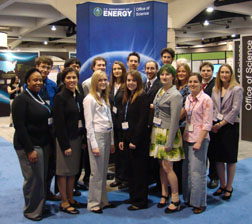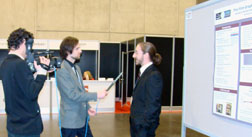Student Researchers Present Findings at Annual Science Meeting
The student presenters participated in 2009 internships through the Science Undergraduate Laboratory Internship (SULI) and the Faculty and Student Teams (FaST) programs sponsored by the DOE Office of Science and The Office of Workforce Development for Teacher and Scientists (WDTS).
"This [meeting] is great exposure for young scientists as they begin thinking about where to attend graduate school and decide which career path to take," said Sam Held, the program coordinator at Oak Ridge Institute for Science and Education (ORISE) in Oak Ridge, Tenn.
Fourteen of the 442 SULI interns and 4 of the 130 FaST interns from the 2009 internship cycle were selected to present their science research projects during a student poster session at the AAAS meeting.
The student posters covered an array of DOE-related science — from improving flexible solar cells to fusion energy to bioremediation.
"These undergraduate students represent the Nation's future highly skilled technical workforce," said Bill Valdez, Director of WDTS within DOE's Office of Science.
The student presenters were selected based on their final internship reports, similar to a journal-quality scientific paper, a requirement of many DOE internship programs. "We received excellent nominations from the DOE National Laboratories, and it was difficult to review them and narrow it down to just 18 for the AAAS meeting," said Shannon Dunphy Lazo, the WDTS Program Manager and Editor of the Journal of Undergraduate Research.
Alex Xu, a senior material science and mathematics student at the Massachusetts Institute for Technology (MIT), conducted research at Argonne National Laboratory on how to dispense a thin film of a substance only one atom thick. According to Xu, "this work is the holy grail of catalysis — the study of the rate of a chemical reaction. Even though my results are very similar to the industrial standard, we are developing new testing methods that may improve predictions during a reaction."
Joanne Osburn, a non-traditional student studying biology and chemistry at the California State University – East Bay, conducted her research at Lawrence Livermore National Laboratory. "I developed a new statistical model to determine the source of a pathogen," said Osburn. In her study, Osburn used data from a well-documented transmission of the HIV virus by a dentist in Florida. "The goal [of my project] is to have a quantitative method [to track a pathogen], such as in the case of bio-terror."
Evan Davis, a senior physics and applied mathematics student at University of California, Riverside, wrote a data analysis package in MATLAB (a numerical computing environment and programming language) to measure the frequency and strength of plasma discharge oscillations in fusion experiments.
The internship participants recognize the value of their national lab experiences and have big plans for their future scientific studies. "I appreciate what they [the scientists at Argonne National Laboratory] have done for me," concluded Xu. "It was exciting to be working in a cutting-edge science during the summer." "I hope to study computation plasma physics for applications with fusion energy at either MIT or Princeton," concluded Davis.
The SULI program has been in effect since the inception of DOE's predecessor agencies. Although the program has gone by many different names, it has supported tens of thousands of undergraduate students with science internships over the past 60 years.
The FaST program consists of one faculty member and up to 3 undergraduate students. The faculty member identifies a mutually beneficial research area amenable to collaboration by the faculty member and the laboratory scientist. The research is completed at one of the DOE national laboratories during the summer.
"The internship programs are competitive," said Sue Ellen Walbridge, Program Manager in WDTS that administers the SULI program. Every year, the education department of each National Laboratory sifts through thousands of applications and evaluates the applicant pool based on their academic coursework, recommendations, scientific interests, and compatibility with the research programs at the facilities.
One common thread is clear: these programs are a springboard to careers in science. "This program exposes students to work at state-of-the-art laboratories where they work with top scientists in the country addressing issues of national need" said Walbridge.
The Department of Energy Office of Science Workforce Development for Teachers and Scientists program conducts four internship programs, including the Summer Undergraduate Laboratory Internship (SULI), Faculty and Student Teams (FaST), Community College Institute (CCI), and Pre-service Teacher (PST), as part of a continuum of opportunities to the Nation's students and teachers of science, technology, engineering and mathematics (STEM).
To learn more about the DOE internship programs and upcoming application dates, please visit www.scied.science.doe.gov.

 Photo Credit - Shannon Dunphy
Photo Credit - Shannon Dunphy Photo Credit - Shannon Dunphy
Photo Credit - Shannon Dunphy